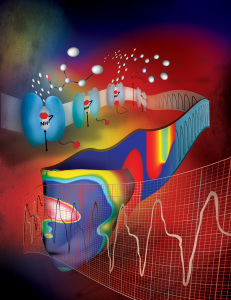Bio
“Sex, Drugs and Funky Rhythms”
 Colleen E. Clancy, Ph.D., is a Professor of Pharmacology at University of California Davis, School of Medicine, Davis, California. She received her B.S. (Biology/Math) at Union College of Schenectady, New York, her Ph.D. (Biophysics/Physiology) at Case Western Reserve University in Cleveland, Ohio, and her completed her Postdoctoral training at Columbia University in New York, New York. She is the author of 50+ publications, serves on the advisory board of the National Biomedical Computation Resource, the Heart Rhythm Society Fellowship Subcommittee, and engages in peer review for numerous granting agencies and peer-reviewed journals. The Clancy Lab focus includes areas of research involving 1) modeling of nonlinear excitable systems; (2) computational pharmacology; (3) modeling and simulation of reaction and diffusion; (4) computational approaches to link genotype to phenotype. Her work has been featured in Scientific American, BBC radio and International Innovation.
Colleen E. Clancy, Ph.D., is a Professor of Pharmacology at University of California Davis, School of Medicine, Davis, California. She received her B.S. (Biology/Math) at Union College of Schenectady, New York, her Ph.D. (Biophysics/Physiology) at Case Western Reserve University in Cleveland, Ohio, and her completed her Postdoctoral training at Columbia University in New York, New York. She is the author of 50+ publications, serves on the advisory board of the National Biomedical Computation Resource, the Heart Rhythm Society Fellowship Subcommittee, and engages in peer review for numerous granting agencies and peer-reviewed journals. The Clancy Lab focus includes areas of research involving 1) modeling of nonlinear excitable systems; (2) computational pharmacology; (3) modeling and simulation of reaction and diffusion; (4) computational approaches to link genotype to phenotype. Her work has been featured in Scientific American, BBC radio and International Innovation.
 Click here to view webcast.
Click here to view webcast.
Abstract
“Sex, Drugs and Funky Rhythms”
 Common paroxysmal electrical diseases that affect millions of Americans are notoriously difficult to manage with drug therapy, and some drugs intended for therapy can even exacerbate disease. A vital hindrance to safe and effective drug treatment of excitable disorders is that there is currently no way to predict how drugs with complex interactions and multiple subcellular targets will alter the emergent electrical activity of cells and tissues. We will present our work on development of a novel quantitative systems pharmacology approach derived from a combination of experiments, computational biology, high performance computing and clinical observation that allows for probing the mechanisms of action of drugs in the settings of one of the most common excitable diseases: cardiac arrhythmias. We will demonstrate how these new tools can be applied to preclinical screening of compounds for therapeutic benefit or harm. We will show how a computer-based approach can be used to determine mechanisms of drugs, with a specific focus to conduct failure analysis for once promising drugs that have failed clinically. Finally, models will be applied to demonstrate utility in guiding therapy for specific clinical situations and to identify optimal “polypharmacy” to inform the common practice of clinical empirical mixing and matching of drugs to create multidrug therapeutic regimens. The computational processes that we have developed are paradigms for how the explosion in systems and computational biology can be utilized to assist drug-screening, determination of mechanisms and to guide therapy. The eventual goal is a scalable, automated platform that will interact with other cutting edge technologies to serve purposes in industry, academia and in clinical medicine that will be widely expanded to pharmacology of other common disorders of excitability such as epil
Common paroxysmal electrical diseases that affect millions of Americans are notoriously difficult to manage with drug therapy, and some drugs intended for therapy can even exacerbate disease. A vital hindrance to safe and effective drug treatment of excitable disorders is that there is currently no way to predict how drugs with complex interactions and multiple subcellular targets will alter the emergent electrical activity of cells and tissues. We will present our work on development of a novel quantitative systems pharmacology approach derived from a combination of experiments, computational biology, high performance computing and clinical observation that allows for probing the mechanisms of action of drugs in the settings of one of the most common excitable diseases: cardiac arrhythmias. We will demonstrate how these new tools can be applied to preclinical screening of compounds for therapeutic benefit or harm. We will show how a computer-based approach can be used to determine mechanisms of drugs, with a specific focus to conduct failure analysis for once promising drugs that have failed clinically. Finally, models will be applied to demonstrate utility in guiding therapy for specific clinical situations and to identify optimal “polypharmacy” to inform the common practice of clinical empirical mixing and matching of drugs to create multidrug therapeutic regimens. The computational processes that we have developed are paradigms for how the explosion in systems and computational biology can be utilized to assist drug-screening, determination of mechanisms and to guide therapy. The eventual goal is a scalable, automated platform that will interact with other cutting edge technologies to serve purposes in industry, academia and in clinical medicine that will be widely expanded to pharmacology of other common disorders of excitability such as epil